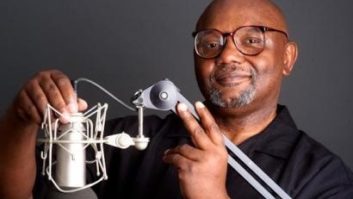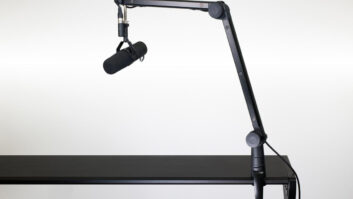I remember the first time I saw the KMS 105.
(click thumbnail)The KMS 105 Microphone
I recall thinking to myself – and saying to the Neumann reps – “As good as this mic sounds, getting proper attention for it is going to be very difficult. Neumann isn’t the first name that comes to mind for a hand-held, front-address microphone. Besides, the KMS 105 is a condenser. The market leaders in live sound and broadcast are usually dynamics.”
I was right.
Getting the ball rolling took some effort, but the KMS 105 won several industry awards in the last 12 months as a live sound and vocal microphone. These awards would not have come unless a large number of people thought it was a thoughtfully designed piece at the right price.
Please don’t eat the mic
Live vocal mics typically get “eaten.” Think about some of the most important features – each is tailored for voice response; most mics are pop-resistant and have a very tight pattern to reduce the possibility of feedback.
Mic feedback is not usually a problem in radio station air studios unless you have the cans turned up really loud and turn your head so that one ear is right by the mic.
Regular cardioid condenser mics frequently pick up too much detail, including sound bouncing off the studio glass, hard drives, computer cooling fans and motors.
When the pattern is too tight, your Morning Zoo starts sounding off-mic every time someone turns his or her head. Oh yeah, and a lot of jocks like to eat the mic too.
That is why the radio market has held onto the EV RE20 (and RE27) this long; the RE mics are fairly forgiving about where you work them, they don’t have too much proximity effect, and you can’t hear the fans and drives all that much.
Neumann has positioned the KMS 105 as a vocalist microphone. There are no roll-offs or pads on the unit.
PRODUCT CAPSULEThumbs up
+ Supercardioid condenser with dynamic mic plug-and-play sensitivity
+ With adjustments it can sound like a dynamic
Thumbs down
– No roll-off
– No pad
– Requires phantom power
Contact: Neumann USA in Connecticut at (860) 434-5220, fax (860) 434-3148 or visit the Web site at www.neumannusa.com
The works
The mic is a supercardioid, pressure-gradient transducer with a sensitivity of 4.5 mV/Pa, a self-noise of 18 dB-A and a maximum SPL of 150 dB. It requires a full 48 VDC phantom supply, consumes 3.5 mA and wants to see a load of at least 1 kohms.
Unscrew the headgrille and you’ll reveal the inner workings of the pop filters and capsule. There are four pop filters. A second finer metal mesh screen that sits about 1/2-inch below the first one complements the coarse metallic outer screen.
A third screen is built around a circular plastic support that slips over the capsule. It sits about 1/2-inch above the diaphragm and also covers the side ports of the capsule.
The fourth filter is finer yet and is integrated into the top of the capsule itself. You can pop the KMS 105, but it is definitely pop-resistant. If you have chronic poppers, you’ll need extra help.
Special K
The 3/4-inch K 105 capsule was developed from the K 50 capsule, found in the KMS 150, KM 150 and KM 185 microphones.
The K 105 capsule features a supercardioid pattern. This pattern is achieved through specially modifying the response of the K 50 pressure gradient transducer.
The capsule itself unscrews from the body, revealing a spring that is mounted on a slender circuit board that runs down through a metallic tube inside the handle. A small gold-plated probe on the bottom of the capsule fits into the center of the spring, connecting the capsule to the circuit board.
This configuration makes the capsule easily replaceable in the field. A small rubber-like isolation bushing separates the metallic tube from the body.
Whereas most condenser mics are a lot more sensitive than most dynamics, the sensitivity of the KMS 105 is only slightly more sensitive than a dynamic microphone, making it easily interchangeable with dynamic mics.
The mic is barely 5 dB louder than an original Sennheiser 421. By comparison, the KMS 105 also makes the 421 sound darker or covered, even with the 421’s presence peak.
The unit is about 2 to 3 dB hotter than the ElectroVoice RE27 N/D. With none of its filters engaged, the RE27 sounds brighter and somewhat metallic relative to the KMS 105.
Engaging the HF roll-off on the RE 27 reduces the metallic sound and makes the two mics sound more similar, but each has different midranges and slightly different proximity effects. The RE27 definitely builds a lower and larger bass note than the KMS 105.
The KMS has a fairly flat response down to 50 Hz at a distance of about two inches. Many mics that have a presence peak that begins somewhere between 2 kHz and goes up to 6 kHz, but the KMS 105 remains basically flat until about 6 kHz. From there, it rises to 12 kHz and is back down to 0 dB by 15 kHz. That frequency range exhibits a lot of “air,” which results in an open sound.
By comparison, the RE27 – with treble tilt on – sounded like someone had dropped a blanket on it. With respect to the tightness of the patterns, both RE27 and KMS 105 begin to fall off at about the same distance; either side to side or directly back.
Bass in your ear
If you have become addicted to the low frequency “whun” or heft of the RE20/27, the KMS 105 will sound thinner on the bottom. That is not to say the KMS 105 lacks bass response. It has it, but at a slightly higher frequency.
The bass response of the KMS 105 does not fill the headphones as thickly as does the RE20/27. This can be either good or bad. On my voice, the RE20/27 can get too thick unless I am at least four inches away.
In an effort to quantify the low-end differences, I recorded a voice track using the KMS 105 through my GML mic preamp and into my Audicy workstation. With no EQ, I thought my voice sounded good and not particularly lacking in low end.
However, it did not have that RE 20/27 low-end sound. I EQed the track by adding 3.5 dB at 88 Hz with a middle-wide Q. This filled the speakers with a low-end presence similar to that of the RE 20/27.
I also tried +2.3 dB at 133 Hz and +2.1 dB at 110 Hz with some success, but at those frequencies I started to hear some muddiness in the lower midrange.
Neumann has just finished a prototype suspension mount for the KMS 105, pictured. Price and availability information for the mount are still in the works. The KMS is priced at $595.
I am waiting to see if the KMS 105 will be received by the broadcast market as well as it has been received by the live-sound market.
With as much mic processing as there is in broadcast today, adding a touch of bottom should be easy. If there is enough initial interest from broadcast, a special KMS 105B is not impossible, but you did not hear that from me.
ReachTy Ford at www.jagunet.com/~tford













